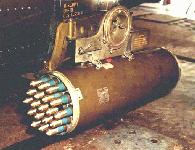
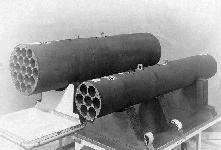
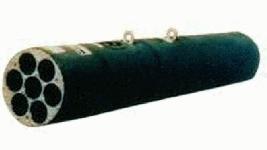
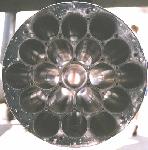
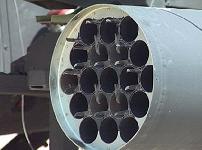



The LAU-61C/A (19 rounds) rocket launcher is thermally coated. The launcher can be fired in single (one at a time) or ripple (one after the other in multiple shots) mode. In ripple mode, the LAU-61C/A can fire 19 rounds in about one second. There are no service life requirements on the launcher. The launchers are mated mechanically to the aircraft by way of suspension lugs. The 2.75 Inch Rocket launchers use 14-inch suspension. Electrical connection between the aircraft and the launcher is made through an electrical receptacle located on top of the launcher center section to the aircraft’s 28 volt armament circuit. The launchers may be shipped and stored pre-loaded with rocket motors. The launchers are a cylindrical construction of 19 aluminum launch tubes. These launch tubes are held together with metal ribs and are covered by an aluminum skin. Launchers can be fitted with forward and aft frangible fairings depending on overall rocket length and fuzing for airborne configuration.
The U.S. Army Lightweight Launchers (LWL) are the M260, 7-tube and the M261, 19-tube launchers. The aluminum launchers are inexpensive enough to be disposable, yet durable enough to be reused after as many as 32 firings. The weight savings over the previous Army launchers allows the Army to add other features to the aircraft's rocket system for improved performance. The launcher permits fuze-timing selection from the cockpit and will launch rockets using either the MK 40 or the MK 66 motors. The aft end of each tube in the launcher is fitted with a pivoting igniter arm which imparts the ignition current from the firing switch to the rocket motor. A side contact is lowered inside the launch tube for MK 66 ignition with the actuation of the pivoting arm. When the rocket is fired, the igniter arm is pushed back and a mechanical link assists in releasing the rocket from the rocket retainer. However, the primary mode of release is rocket override of the retainer in the launcher. The rocket retention force is specified to be between 170 and 600 pounds, easily overridden by the rocket thrust of over 1300 pounds. Weight saving was achieved for the LWL design by minimizing the use of rivets, welding and adhesive. Instead, the launchers are assembled using electromagnetic force to swage the aluminum skin and tubes around the four bulkheads. The center two bulkheads are welded to the aluminum strongback. This strongback establishes the rigidity of the launcher and is designed in accordance with MIL-A-8591 for interface with aviation suspension racks and sway braces. The 19-tube launcher has since been redesigned to implement a floating solid bulkhead at the front of the launcher. This solid bulkhead was necessary to minimize the warping from heat built up during ripple launches. All other bulkheads are a laminated stack of plates. The front bulkhead of the 7-tube launcher continues to use a laminated stack. Electrical connectors are referred to as J1 and J2 connectors. The J1 connector (P/N 13048761 is a 26-pin connector for the motor ignition circuit and the J2 (P/N 13048762) is a 23-pin connector for the fuze setting circuit. The firing interval that the launcher normally experiences from the fire control is 0.06 seconds. Environmental Protection Devices (EPD) have been designed to protect loaded launchers in flight from collecting ice and debris which can cause a rocket to stick in the tube, a condition that can result in a hangfire. The EPDs are molded from an ABS plastic in one piece and mount to the face of the launcher with captive bolts. The EPD effectively protects each tube with a dome cover that is grooved on the surface for fragmentation upon rocket exit. Fragments are designed to not exceed one square inch and can be ingested without event by the turbine engines of the Apache helicopter. A side benefit of the EPD is the thermal protection for the launcher face to prevent warping, which eventually will lead to erosion of the launcher tubes. This also will minimize the heat signature of the launcher after rocket firings.| Configuration | Center of Gravity
(In Inches from Front) | Weight
(lbs) |
|---|---|---|
| Empty | ||
| M229/M423/MK66 (HE) | ||
| M151/M423/MK66 (HE) | ||
| M257/M442/MK66 (Illumination) | ||
| M264/M439/MK66 (Smoke) | ||
| M261/M439/MK66 (MPSM) | ||
| M255A1/M439/MK66 (Flechette) | ||
| M274/MK66 (Practice) |




